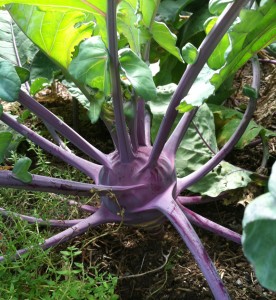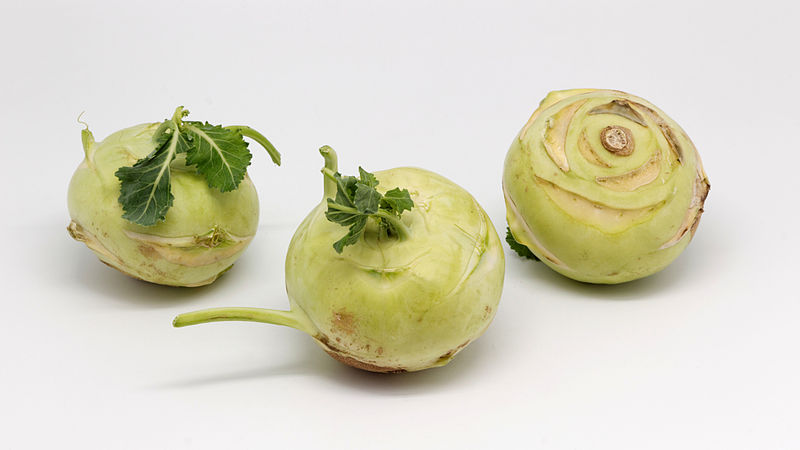Kool Kohlrabi
Posted in Gardening Tips on July 29 2014, by Sonia Uyterhoeven
Sonia Uyterhoeven is the NYBG’s Gardener for Public Education.
 Some vegetables seem to have more cachet than others. Sometimes it’s due to their flavor, other times to their versatility of use. And sometimes, they simply look too cool to ignore…or perhaps I should say “kool.”
Some vegetables seem to have more cachet than others. Sometimes it’s due to their flavor, other times to their versatility of use. And sometimes, they simply look too cool to ignore…or perhaps I should say “kool.”
The curious thing about kohlrabi is that the majority of people have no idea what it is. Few even realize it exists. In terms of its popularity, it’s the runt of the cabbage family—until you lay eyes on it, of course. At that moment, it’s probably the coolest cole you’ve ever seen.
Kohlrabi is a member of the cabbage or Brassica family. Its Latin name—Brassica caulorapa—means “stem turnip.” This is not an auspicious start for an up-and-coming member of the cabbage family. It starts its life looking like all the other members of the Brassica family—cabbage, broccoli, cauliflower—but then it comes into its own as it begins to mature.
As the plant matures, the stem starts to swell as though it has a bad case of gout. It eventually forms a nice, round ball that grows to the size of a tennis ball, or for the giant winter varieties, somewhere around the size of a grapefruit.
Kohlrabi comes in both purple and green varieties. The purple is more ornamental and purported to be hardier, but they both taste about the same and are equally rewarding to grow. They are a cool season crop and are best grown in spring or late summer. You generally harvest them in June or October.
For an early planting, sow 8 weeks before the last frost date and transplant the kohlrabi into the garden six weeks later. For a late season harvest, sow in late July or early August. Most varieties need 50-65 days until maturity, although some of the giant heirloom varieties such as ‘Gigante’ need 130 days until they are ready for harvest.
Like many members of the cabbage family, kohlrabi prefers to grow in moisture retentive soil that is rich in organic matter. It performs best in full sun. Amend the soil with compost or leaf mold to get it off to a good start.
Kohlrabi tends to be more tolerant than many of the cole crops, surviving high temperatures and dryness. That being said, if the weather gets too hot and dry the bulbs will get woody and start to split. The flavor also changes from sweet to hot and fiery. In order for it to get through warm spells successfully, the plant needs plenty of water and mulch.

Many professional growers say that kohlrabi is best as a fall crop, as it will happily grow until a hard freeze. In the cooler fall temperatures and shorter days, kohlrabi stays crisp and tender. Remember to harvest it when the bulbs are around 2 ½ inches in diameter.
As far as taste goes, kohlrabi is similar to a mild cabbage with a slight sweetness. The bulb has a crunchy texture when eaten raw, and you can grate it into a salad just as you would coleslaw. Alternatively, you can bake it, pickle it, or add it to soups. When the leaves are young, they can be steamed or sautéed and eaten just as you would with collard or kale.
Kohlrabi lasts for up to 3 months in your refrigerator, making it a heavenly choice for the indecisive chef. Once you are ready to use it, just peel off the hard outer layer. I perused the internet for recipes and found some easy and wonderful options for kohlrabi slaw, creamy soups, and sweet and savory roasted vegetable dishes, one of which is sure to hit home with you. My personal favorite is this recipe for kohlrabi carrot fritters with avocado cream sauce.
All that’s left is to decide which variety to grow. There’s the heat tolerant ‘Kolibri’ or ‘Winner’; the heirloom varieties such as ‘Early Purple Vienna’ and ‘Early White Vienna’; or the mega coles such as ‘Gigante’ and ‘Kossack’. Whatever you choose, bon appétit and happy growing!

